-
Engine1.8L I4
-
Power130 HP / 128 LB-FT
-
TransmissionCVT
-
DrivetrainFront-Wheel Drive
-
Curb Weight2,851 LBS
-
Seating2+3
-
Cargo15.1 CU-FT
-
MPG30 City / 39 HWY
Creating a competitive new compact sedan in the US is perhaps the hardest chore that big automakers face today. Shoppers in this slice of the market really do require a single vehicle that will do just about everything for them: get great fuel economy, give a comfortable and confident ride, have a usable back seat with plenty of cargo space, offer an abundance of techy bells and whistles. At the top-spec levels, today's compacts face competition from entry-level midsizers, while at the bottom end they must compete with smaller, often more efficient sub-compacts that are better now than they ever have been in our country.
Further complicating things, this is a segment that still holds a lot of performance promise for Gen X and Gen Y buyers. More than a few of these 20- and 30-somethings found their first motoring thrills at the wheel of a Civic Si, Cobalt SS, Jetta GLI or, pertinently, a Sentra SE-R. Being able to feel that warmed-up-performance lineage could be the difference for a section of shoppers here.
Finally, and undoubtedly most important, every one of the new breed of compact competitors must offer easy-to-define value to this ultra-price-sensitive segment. Comparing base-specification MSRPs isn't going to cut it, as a transmission choice here and navigation package there can quickly raise your bottom line from $18,000 to $26,000 and more.
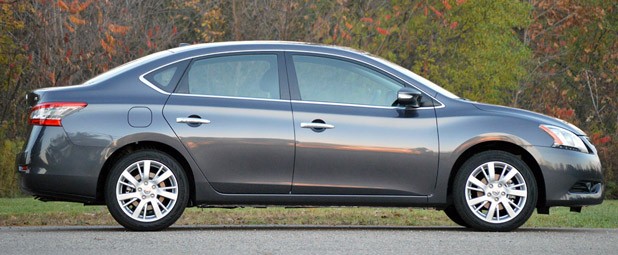
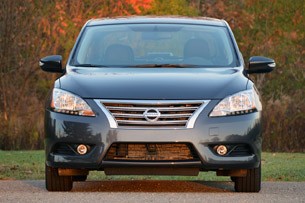
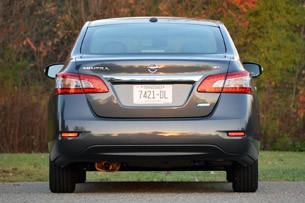
Like most of the competitive set, the 2013 Nissan Sentra makes its first play for conquest customers with completely revised sheetmetal. And, while the very general proportions have carried over from the sixth to this new seventh-generation Sentra – the stubby, wide nose and abbreviated trunk lid are both familiar – this new car looks very little like its sharply creased predecessor. If we're blunt, we don't care much for what the designers have done. The rounded, pugnacious front end gives the Sentra added visual height from the front view, while the high beltline and bulging character line do the same for the profile view. In total, despite the fact that this Sentra is just a little bit lower and longer than the last model, it looks altogether more top-heavy.
You'll have ample opportunity to peep the new design for yourself and make up your own mind about the aesthetic plusses and minuses of this Sentra, but suffice it to say that we found the car distinctly less attractive the first time we saw it in person, rather than in photographs.The backseat is as capacious as we've seen in the segment.
Nissan has done a good job increasing the interior volume of the new car, especially if the bit that you care about is in the backseat. That back section, with seating for three abreast, is as capacious as we've seen in the segment to date. (Note that, as with the Hyundai Elantra, for instance, the interior volume of the Sentra is actually large enough that the EPA classifies it as a midsize, rather than compact, sedan.) Room up front is about average for the class, however. Drivers more than six-feet tall are going to wish that Nissan had made the front-seat rails go back another inch. What's more, on models with the powered sunroof, tall folks (like your author) will wish that the seat bottom moved down another click or two.
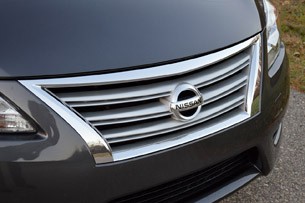
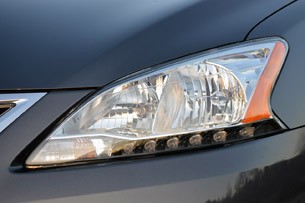
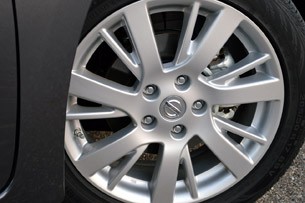
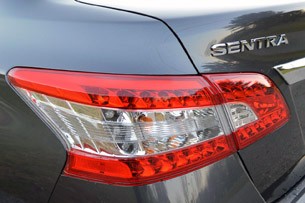
We were able to snag a top-spec Sentra SL for this First Drive report, so we really did get the best that the model has to offer in terms of interior amenities and creature comforts. Adding the Leather (which also adds rear disc brakes, oddly), Premium and Navigation packages ensured that we wouldn't go without two-stage heated front seats, Bose audio, a 5.8-inch infotainment screen with backup camera, that powered sunroof and a few more odds and ends. Overall the SL felt like a very complete, well-screwed-together cabin with respectable material quality as well as fit and finish (especially considering we had a pre-production model).
Some noticeable detractors from the experience were the regrettable wood trim pieces on the center tunnel and the doors, as well as an overly large, thin-rimmed steering wheel that felt as if it were sized for a pickup rather than a compact car. Thankfully, we know that other Sentra trim levels do away with the wood bits – the steering wheel is just something we'd have to live with. Our predilection would be for a set of front seats with larger side bolsters than these very flat Sentra seats offered, though we must admit that the cushions felt nicely padded for long-range cruising.Another surprising plus to the driving experience is the exceptionally well-managed noise, vibration and harshness.
Another huge and frankly really surprising plus to the driving experience is the exceptionally well-managed noise, vibration and harshness. We only really noticed the car's exhaust note when we were accelerating hard – where the Continuously Variable Transmission causes a one-note drone that sets our teeth on edge. When keeping a steady throttle, even at highway speeds up to 80 miles per hour, the Sentra was remarkably still. Just bit of wind rush from the side-view mirrors interrupted the quite-cruise nature here. We'd have to do an honest comparison test to tell you for sure, but our memories of the Elantra, Focus, Civic, Mazda3 and the rest are not nearly so refined in terms of cabin volume.
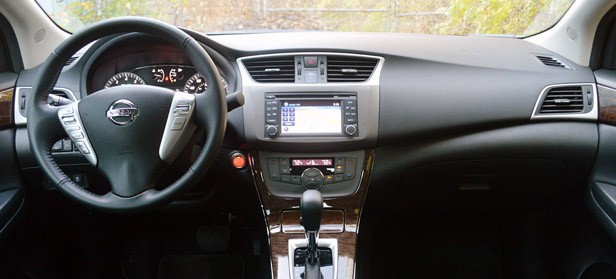
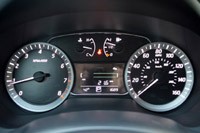
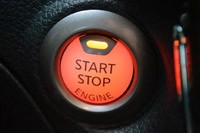
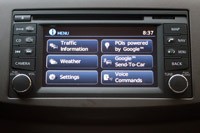
The new Sentra's ride quality was nearly as impressive as its noise, vibration and harshness tuning, as here again the Nissan made a passable impression of a larger, more expensive vehicle. Suspension compliance over potholes and such was excellent; the Sentra's primary ride was rarely upset by a cracked bit of asphalt or even some washboard-like sections we found on an unpaved back road. At the same time, this rough-road mitigation didn't come at the expense of float over larger swales or small hills when taken at speed, nor did it mean that the Sentra exhibited a lot of lean in aggressive cornering. In fact, whether we were just kicking back on the highway or pushing the car pretty hard on a fun road, the Sentra's suspension kept the wheels firmly planted on the road, with not much kickback in the steering or through the seats.
This fine balance shouldn't be confused with an overly sporting character overall, however. This model does not hit a lot of high points for enthusiast drivers, despite its well-judged ride and handling balance.This isn't the car that will reinstall the glory of the B13 SE-R.
For instance, the steering, while not what we'd call over-boosted, is pretty lazy for what we've come to expect from the Sentra nameplate. (Going back to our earlier point, this isn't the car that will reinstall the glory of the B13 SE-R.) At moderate speeds on gently curved roads, this rack does just fine. But if you increase either the pace of driving or the complexity of the corners, you soon find the steering feedback insufficient to make out how much grip is left, and the response time from input to reaction is far too slow to make the Sentra feel light on its feet. Blame some of this lethargy on the extended wheelbase and slower rotational ability of this larger car. But the truth is that sharper sedans, like the Focus or Mazda3, feel more athletic than does this Nissan.
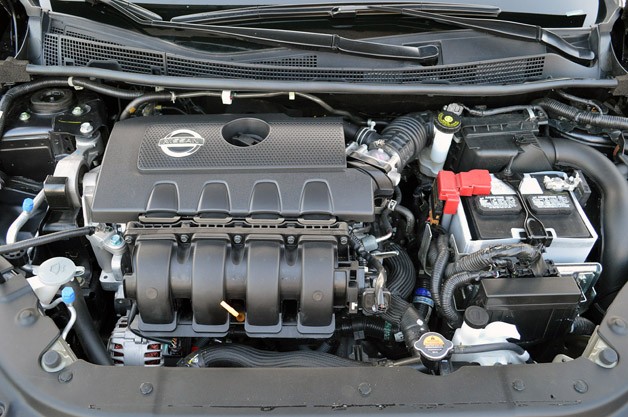
And, of course, the combination of Nissan's 1.8-liter four-cylinder and its revised continuously variable transmission hugely colors our impressions of the vehicle. The new engine is thoroughly more efficient and has a higher specific output than the old Sentra's 2.0-liter mill, though with just 130 horsepower and 128 pound-feet of torque it doesn't get the car moving with any sense of urgency. Likewise, the CVT has been enhanced with a sub-planetary gear and smaller pulleys, aimed at better low-down response and improved high-speed fuel economy, but without doing much for driving satisfaction.
We'll buy the story that this trans is smoother overall, with more pop at low speeds than the last one, but it remains far from an engaging item for anyone who cares about the joy of driving. Nissan has gone so far as to attempt to vary the driving character a bit, offering a Sport and Eco button to increase or decrease throttle keenness, but the primary result of selecting one or the other seems to be the volume at which the engine drones at half-open throttle.With just 130 horsepower and 128 pound-feet of torque, it doesn't get moving with any sense of urgency.
Nissan does offer a six-speed manual gearbox for the base Sentra S, which we have yet to drive, but the vast majority of Sentra buyers will end up with the CVT. And that's okay, because as long as you disabuse yourself of any notion of this Sentra as a driver's car, you'll see that it scores highly on the most important of our initial judging criteria: value.
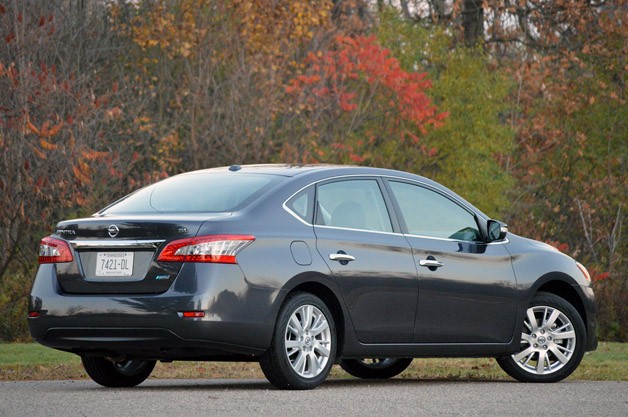
Yep, like the Versa before it, Nissan is absolutely making a play to have this Sentra be the content-per-dollar champ of the key compact segment. Our kitted-out SL carried an as-tested price of $23,420 – that's about $3k worth of options after you figure a post-destination and handling MSRP of $20,540. For the sake of argument, we spec'd out some of the mainstream competitor cars in a similar fashion, to see what we could discover. (Note that we were trying to configure each model with the same automatic transmission, leather seating, larger wheels, navigation and premium audio as our Sentra had.)
The closest-to-matching Jetta and Civic climbed over the $26k mark. The Mazda3, Cruze and Focus were all in the $25k range. Hyundai's very competitive Elantra was a few hundred dollars more dear at just over $24k, while its cousin the Kia Forte offers fundamentally the same equipment as the Sentra for $300 more. Now, bear in mind that most of the models mentioned here have either more power than the Sentra, or fare less well than the Nissan's 30/39 mile per gallon City/Highway ratings for fuel economy. With that said, and with the Sentra's very frugal fuel econ noted, it's hard to say that any compact car in the market today offers more bang for your buck than this Sentra.Nissan is absolutely making a play to be the content-per-dollar champ of the key compact segment.
From a driving standpoint, the Sentra doesn't offer much to get excited about except for refinement and a smooth, confident ride. But the car is obviously very well priced, and the packaging of the thing will work well in the "do-everything" mold that compact car shoppers seem to desire. So, while the Sentra doesn't exactly enflame an enthusiast's heart with passion, we think that the rest of the players in this cutthroat segment had better watch their backs.
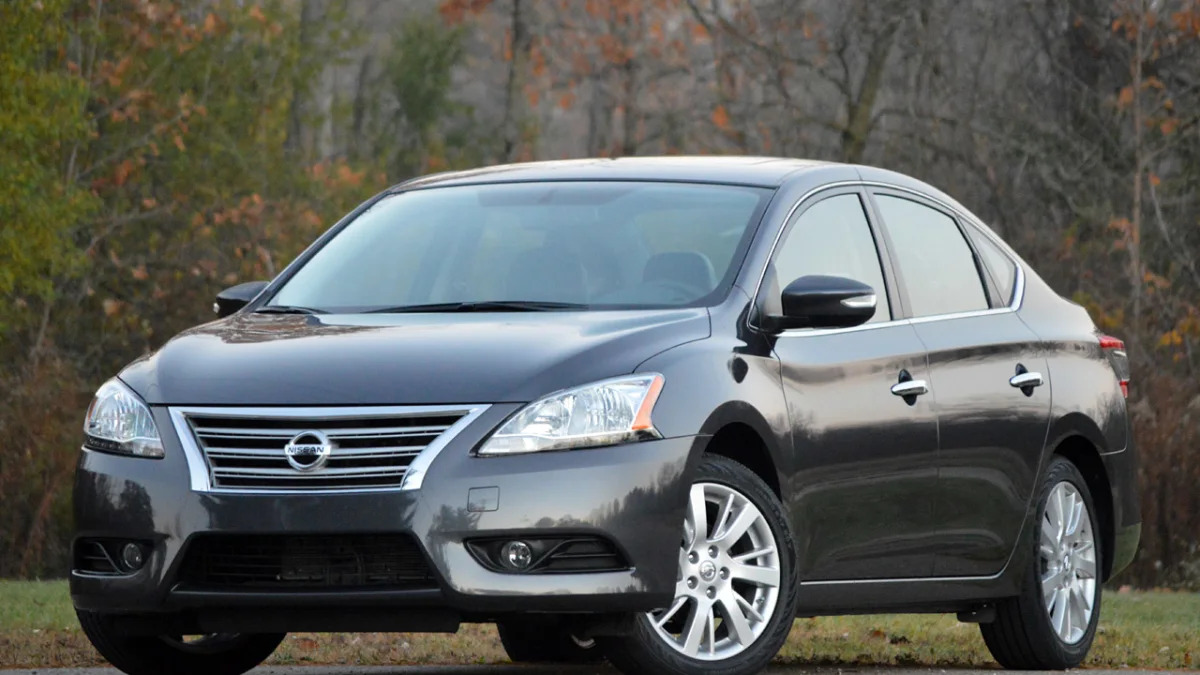









Sign in to post
Please sign in to leave a comment.
Continue